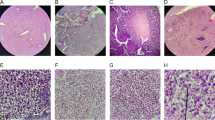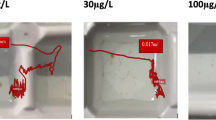Abstract
Domestic chicken embryos are frequently used for avian developmental toxicity studies of polyhalogenated aromatic hydrocarbons, which are often injected into eggs with oil-based vehicles. Injection times range from immediately prior to incubation (embryonic day zero, E0) to after 4 days of incubation (E4) and beyond. Because the majority of organogenesis in chicken embryos occurs during the first 4 days of development, injection after E0 may miss critical, sensitive, developmental periods. We evaluated whether differences in the day of vehicle administration would lead to differences in standard measures of embryotoxicity. We assessed embryotoxicity using mortality, organ somatic indices, teratogenesis, and behavior in hatchling chickens developmentally exposed to a high volume (1.0 μl/g egg) of corn oil vehicle, which was injected into the airsac at E0 or E4. The E0 vehicle group had 76.5% higher overall embryo mortality, embryos died earlier in development, and hatchlings took more than two times longer to right in a righting reflex test compared to the E4 vehicle group. Other behavioral results demonstrated that hatchling chickens from the E0 vehicle group performed differently from their respective no-inject controls, whereas hatchling chickens from the E4 vehicle group did not. The bursal somatic index differed statistically by injection day and weighed 23.7% more in the E0 vehicle group than the E4 vehicle group. These results suggest that the embryonic day of contaminant injection is an important consideration, particularly when using a high volume of vehicle to evaluate developmental toxicity of a contaminant on embryo mortality or behavior.


Similar content being viewed by others
References
S Ameenuddin ML Sunde (1984) ArticleTitleSensitivity of chick embryo to various solvents used in egg injection studies Exp Biol Med 175 176–178
B Brunström (1990) ArticleTitleMono-ortho-chlorinated chlorobiphenyls toxicity and induction of 7-ethoxyresorufin O-deethylase (EROD) activity in chick embryos Arch Toxicol 64 188–192
B Brunström L Andersson (1988) ArticleTitleToxicity and 7-ethoxyresorufin O-deethylase-inducing potency of coplanar polychlorinated biphenyls (PCBs) in chick embryos Arch Toxicol 62 263–266
RW Carlson RT Duby (1973) ArticleTitleEmbryotoxic effects of three PCB’s in the chicken Bull Environ Contam Toxicol 9 261–266
PJ Cowan (1973) ArticleTitleParental calls and the approach behavior and distress vocalization of young domestic chicken Can J Zool 51 961–967
JC DeWitt EB Meyer DS Henshel (2005) ArticleTitleEnvironmental toxicity Studies using chickens as Surrogates for wildlife: effects of vehicle volume Arch Environ Contam Toxicol 48 260–269
M Engwall B Brunström E Jakobsson (1994) ArticleTitleEthoxyresorufin O-deethylase (EROD) and aryl hydrocarbon hydroxylase (AHH)-inducing potency and lethality of chlorinated naphthalenes in chicken (Gallus domesticus) and eider duck (Somateria mollissima) embryos Arch Toxicol 68 37–42
BM Freeman MA Vince (1974) Development of the avian embryo: A behavioral and physiological study Chapman and Hall London
E Gustafsson B Brunström U Nilsson (1994) ArticleTitleLethality and EROD-inducing potency of chlorinated chrysene in chick embryos Chemosphere 29 2301–2308
R Hashizume N Atsushi I Masaya Y Yamamoto S Masui M Oka T Nakamura (1992) ArticleTitleStudies on teratological testing using chicken embryos—effects of solvents, injection sites and the age of the embryo Exp Anim 41 349–356
Y Hatano A Hatano (1994) ArticleTitleInfluence of tetrachlorodibenzo-p-dioxin on the growth of chick embryos J Toxicol Environ Health 42 357–364
DJ Hoffman MJ Melancon PN Klein JD Eisemann JW Spann (1998) ArticleTitleComparative developmental toxicity of planar polychlorinated biphenyl congeners in chickens, American kestrels, and common terns Environ Toxicol Chem 17 747–757
DM Janz GD Bellward (1996) ArticleTitleIn ovo 2,3,7,8-tetrachlorodibenzo-p-dioxin exposure in three avian species. 1. Effects on thyroid hormones and growth during the perinatal period Toxicol Appl Pharmacol 139 281–291
X Jin SW Kennedy T Di Muccio TW Moon (2001) ArticleTitleRole of oxidative stress and antioxidant defense in 3,3′,4,4′,5-pentachlorobiphenyl-induced toxicity and species-differential sensitivity in chicken and duck embryos Toxicol Appl Pharmacol 172 241–248
RB Jones (1993) ArticleTitleReduction of the domestic chick’s fear of human beings by regular handling and related treatments Anim Behav 46 991–998
RB Jones D Waddington (1992) ArticleTitleModification of fear in domestic chicks, Gallus gallus domesticus, via regular handling and early environmental enrichment Anim Behav 43 1021–1033
EL Masteller GT Pharr FE Funk CB Thompson (1997) ArticleTitleAvian B cell development Int Rev Immunol 15 185–206
MB Newby-Schmidt S Norton (1981) ArticleTitleDetection of subtle effects on the locomotor ability of the chicken Neurotoxicol Teratol 3 45–48
E Nikolaidis B Brunström L Dencker (1988) ArticleTitleEffects of the TCDD congeners 3,3′,4,4′-tetrachlorbiphenyl and 3,3′,4,4′-tetrachloroazoxybenene on lymphoid development in the bursa of Fabricius of the chick embryo Pharmacol Toxicol 92 315–323
BM Patten (1971) Early embryology of the chick EditionNumber5 McGraw-Hill Book Company New York
C Prada J Puga L Perez-Mendez R Lopez G Ramirez (1991) ArticleTitleSpatial and temporal patterns of neurogenesis in the chick retina Eur J Neurosci 3 559–569
LJ Rogers (1995) The development of brain and behaviour in the chicken CAB International Wallingford, UK
A Romanoff (1960) The avian embryo The Macmillan Company New York
A Romanoff A Romanoff (1972) Pathogenesis of the avian embryo John Wiley and Sons Inc. New York
CA Sanderson LJ Rogers (1981) ArticleTitle2,4,5-Trichlorophenoxyacetic acid causes behavioral effects in chickens at environmentally relevant doses Science 211 593–595
JT Sanderson GD Bellward (1995) ArticleTitleHepatic microsomal ethoxyresorufin-O-deethylase-inducing potency in ovo and cytosolic Ah receptor binding affinity of 2,3,7,8-tetrachlorodibenzo-p-dioxin: comparison of four avian species Toxicol Appl Pharmacol 132 131–145
CG Scanes LE Hart E Decuypere ER Kuhn (1987) ArticleTitleEndocrinology of the avian embryo: an overview J Exp Zool Suppl 1 253–264
KR Schrankel BL Kreamer MTS Hsia (1982) ArticleTitleEmbryotoxicity of 3,3′,4,4′-tetrachloroazobenze and 3,3′4,4′-tetrachloroazoxybenzene in the chick embryo Arch Environ Contam Toxicol 11 195–202
U Sirkka R Pohjanvirta SA Nieminen J Tuomisto P Ylitalo (1992) ArticleTitleAcute neurobehavioral effects of 2,3,7,8-tetrachlorodibenzo-p-dioxin (TCDD) in Han/Wistar rats Pharmacol Toxicol 71 284–288
O Spreen D Tupper A Risser H Tuokko D Edgell (1984) Human developmental neuropsychology Oxford University Press, Inc. New York
HA Tilson (1993) ArticleTitleNeurobehavioral methods used in neurotoxicological research Toxicol Lett 68 231–240
I Turro RH Porter M Picard (1994) ArticleTitleOlfactory cues mediate food selection by young chicks Physiol Behav 55 761–767
EK Wehler B Brunström U Rannug A Bergman (1990) ArticleTitle3,3′,4,4′-tetrachlorobiphenyl: metabolism by the chick embryo in ovo and toxicity of hydroxylated metabolites Chem Biol Interactions 73 121–132
IC Weill CA Reynaud (1987) ArticleTitleThe B cell compartment Science 238 1094–1098
B Weiss DA Cory-Slechta (1994) Assessment of behavioral toxicity AW Hayes (Eds) Principles and methods of toxicology EditionNumber3 Raven Press Ltd New York 1091–1155
Author information
Authors and Affiliations
Corresponding author
Rights and permissions
About this article
Cite this article
DeWitt, J.C., Meyer, E.B. & Henshel, D.S. Environmental Toxicity Studies Using Chickens as Surrogates for Wildlife: Effects of Injection Day. Arch Environ Contam Toxicol 48, 270–277 (2005). https://doi.org/10.1007/s00244-004-2006-8
Received:
Accepted:
Published:
Issue Date:
DOI: https://doi.org/10.1007/s00244-004-2006-8




